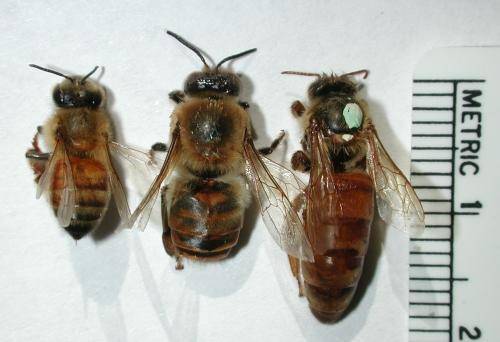About Bees
Bee Basics
Honey bees are social insects, they live together in an organised colony and depend on each other for survival.
Most of the bees in a colony are workers. Some are drones who are males and their function is to mate with a virgin queen. Usually there is only one queen in a colony.
Worker bees are non-developed females. There may be as many as 60,000 in a colony. The population of a colony depends on a number of factors such as: the age and egg-laying ability of the queen, the space available in the hive and the amount of the food supply.
They are called workers because that is what they do. They collect food and water for the colony, build wax comb, do the housework, maintain the interior temperature of the hive,guard the hive against intruders and they can sting. Female worker bees under certain conditions can lay eggs but because they are not mated, they produce eggs that only develop into drones.
Drones are the males in the colony.Note the general shape of the drone: they differ from the workers in that the head is large and the eyes predominate the head, the rear-end of the drone is square, they have no stinger and can not sting. The worker bees usually determine the number of drones that can be found in a colony. A strong healthy colony may have as many as 300 drones. As winter approaches, the workers drive the drones from the hive to starve.
The queen is a mature female. She lays thousands of eggs during her life time. A good queen may lay over 2000 eggs in a single day. A queen is the longest-lived in the colony and can live for up to five years. She is larger than the other bees in the hive and has a slim torpedo shape.
Worker Drone Queen
The beekeeper who is successful at his craft provides the bee colony with adequate supplies of each of the following: a place to live, nectar, pollen, propolis, and water.
A place to live: In the wild, the honey bee uses a number of natural cavities to build their brood nest. Cavities in trees are a common place to find a wild hive. Man can keep bees by providing them with the equivalent of a hole in a tree.
Nectar: Bees can't make honey without nectar, the liquid sugary substance produced by flowers. Hundreds of plants produce nectar but they are not all major sources of honey. However, bees do produce crops of honey from certain major nectar sources which inlclude: bramble, dandelions, clover, heather, oil-seed rape, and many wild flowers.
Pollen: As worker bees gather nectar from flowers, tiny particles of pollen stick to their bodies and are accumulated in pellets on their hind legs. The hind legs are equipped with pollen baskets: hairs and special structures on the bees' leg to carry the pollen back to the hive. Pollen is sometimes referred to as "beebread". Pollen contains the nutrients that are converted into larval food by special glands in the worker bees which is then used to feed young larvae. It should be noted that honey bee workers also produce what is called "Royal Jelly". Royal Jelly is a special food that is given to larvae that are destined to become queen bees.
Propolis: This substance is used by the bees to cement holes and cracks in their hive. It is gathered by honey bees from secretions produced by trees and shrubs.
Water: As for all living things water is essential for the survival of the hive. Bees should always be located near a good water source or one should be provided by the beekeeper.
